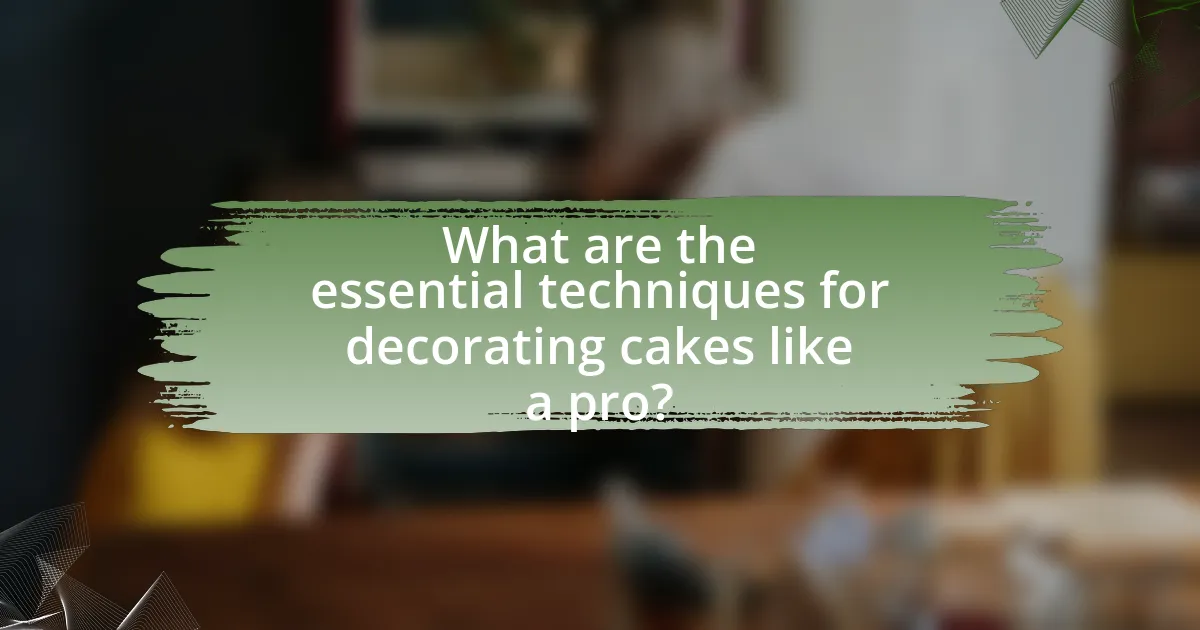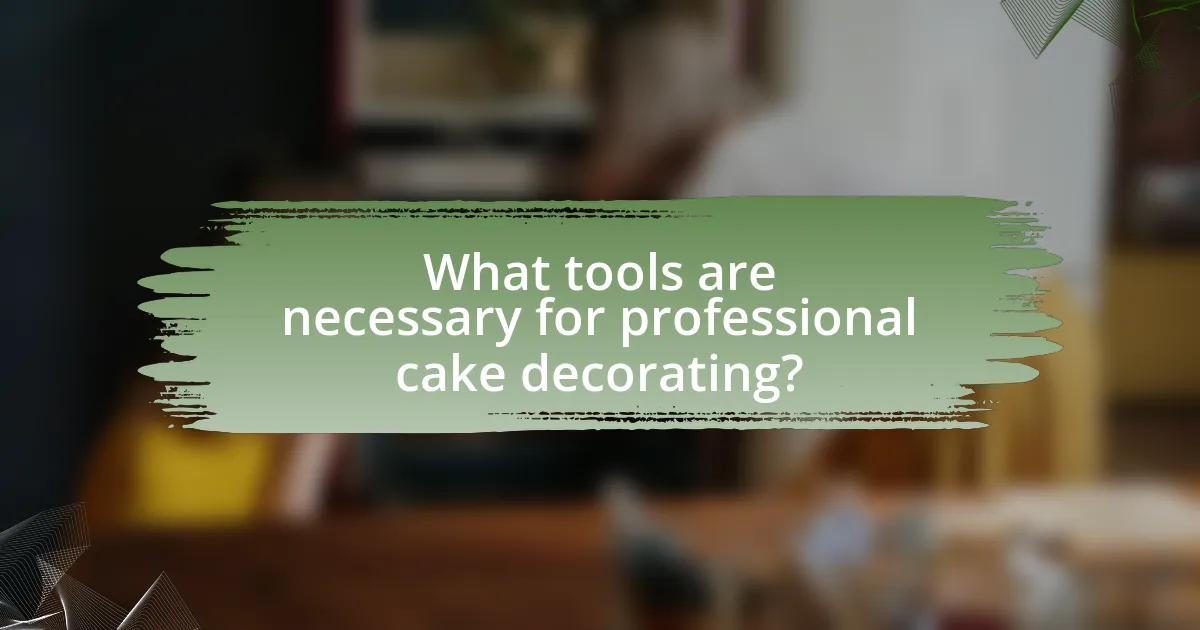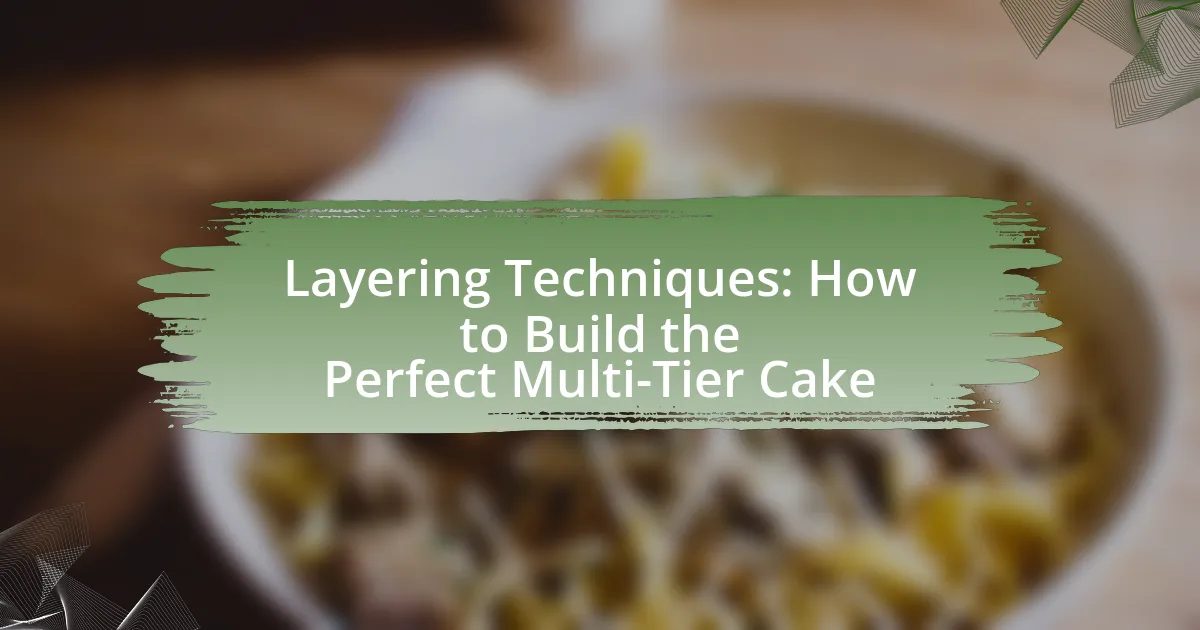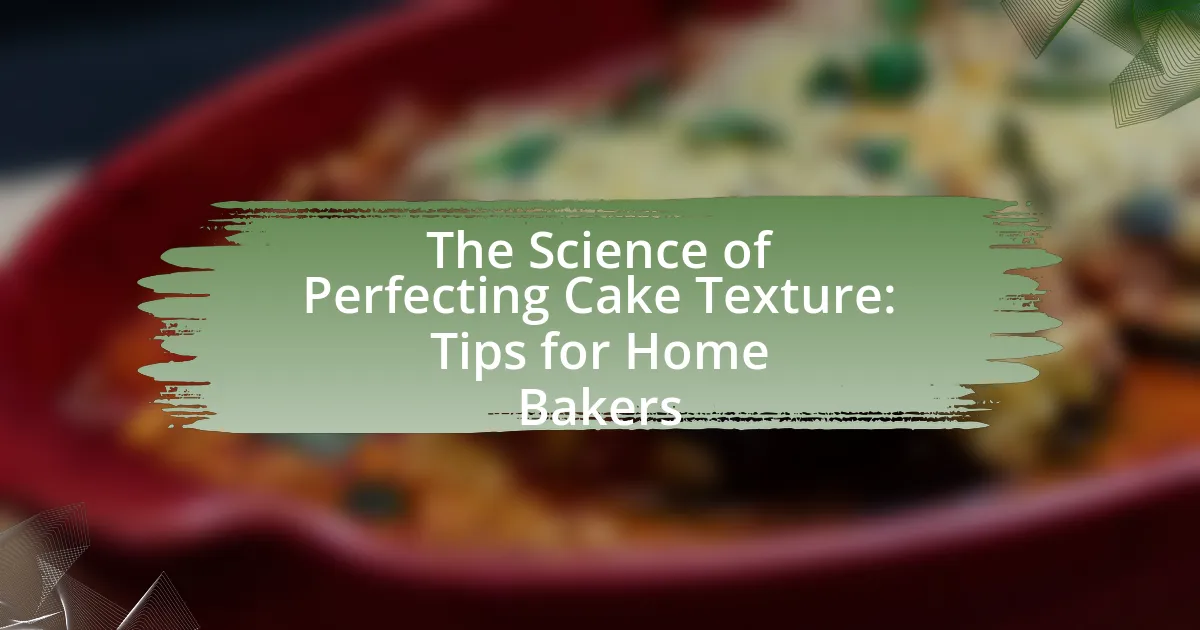The article focuses on essential techniques and tools for decorating cakes like a professional. It covers fundamental skills such as fondant application, piping, and airbrushing, which enhance the visual appeal and stability of cakes. Additionally, it discusses advanced techniques and tools that can elevate cake designs, including airbrushing and fondant sculpting. The article also emphasizes the importance of proper tool maintenance and troubleshooting common decorating challenges to achieve a polished finish. Overall, it provides a comprehensive guide for both beginners and experienced decorators to improve their cake decorating skills.

What are the essential techniques for decorating cakes like a pro?
The essential techniques for decorating cakes like a pro include mastering the use of fondant, piping, and airbrushing. Fondant allows for smooth, professional finishes and intricate designs, while piping techniques enable the creation of decorative borders and detailed patterns. Airbrushing adds depth and color gradients, enhancing the overall appearance of the cake. These techniques are widely used by professional bakers to achieve visually stunning results, as evidenced by their prevalence in competitive baking and cake decorating classes.
How can mastering basic techniques elevate your cake decorating skills?
Mastering basic techniques significantly elevates cake decorating skills by providing a strong foundation for more advanced methods. Proficiency in fundamental skills such as piping, smoothing, and fondant application allows decorators to create visually appealing and structurally sound cakes. For instance, a study by the American Culinary Federation highlights that decorators who practice basic techniques consistently produce cakes with better aesthetic quality and stability, leading to higher customer satisfaction. This mastery not only enhances creativity but also increases efficiency, enabling decorators to execute complex designs with greater ease and precision.
What are the fundamental techniques every cake decorator should know?
Every cake decorator should know techniques such as leveling, crumb coating, piping, fondant application, and using edible decorations. Leveling involves cutting the cake layers to ensure even surfaces, which is crucial for stability and aesthetics. Crumb coating is the application of a thin layer of frosting to seal in crumbs, providing a smooth base for the final layer of icing. Piping techniques allow decorators to create intricate designs and borders, enhancing the visual appeal of the cake. Fondant application requires skill in rolling and draping fondant over cakes for a polished finish. Lastly, using edible decorations, such as sprinkles or edible flowers, adds texture and color, making the cake more visually appealing. Mastery of these techniques is essential for achieving professional-looking cakes.
How do these techniques impact the overall appearance of a cake?
Techniques such as fondant application, piping, and airbrushing significantly enhance the overall appearance of a cake by providing a polished and professional finish. Fondant creates a smooth, sleek surface that can be molded into various shapes and designs, allowing for intricate decorations. Piping techniques add texture and detail, enabling decorators to create patterns and borders that elevate visual appeal. Airbrushing introduces depth and color gradients, making cakes visually striking and more dynamic. These methods collectively contribute to a cake’s aesthetic, transforming it from a simple dessert into a visually captivating centerpiece.
What advanced techniques can take your cake decorating to the next level?
Advanced techniques that can elevate cake decorating include airbrushing, fondant sculpting, and the use of edible prints. Airbrushing allows for smooth gradients and intricate designs, enhancing visual appeal. Fondant sculpting enables the creation of three-dimensional decorations, adding depth and creativity to cakes. Edible prints provide the ability to transfer detailed images onto cakes, offering customization options that are both professional and visually striking. These techniques are widely used by professional bakers to achieve high-quality results and are supported by industry standards in cake design.
How do techniques like fondant work for professional cake decoration?
Fondant is a pliable icing made primarily from sugar, water, and gelatin, used in professional cake decoration to create a smooth, polished finish. This technique allows decorators to cover cakes seamlessly, providing a canvas for intricate designs and decorations. The elasticity of fondant enables it to be rolled out and draped over cakes, adhering well to various surfaces, which enhances the overall aesthetic appeal. Additionally, fondant can be molded into shapes, figures, and decorations, allowing for creativity and customization in cake design. Its versatility is supported by its ability to be colored and flavored, making it a preferred choice among professional bakers for achieving visually stunning results.
What are the benefits of using airbrushing in cake decorating?
Airbrushing in cake decorating offers several benefits, including the ability to achieve smooth, even color application and intricate designs. This technique allows decorators to create gradients and shading that are difficult to replicate with traditional methods, enhancing the visual appeal of cakes. Additionally, airbrushing can save time, as it covers large areas quickly compared to hand-painting. The use of edible airbrush colors ensures that the decorations are safe for consumption, providing both aesthetic and practical advantages in cake design.

What tools are necessary for professional cake decorating?
Professional cake decorating requires essential tools such as offset spatulas, piping bags, various piping tips, cake turntables, and fondant tools. Offset spatulas are crucial for spreading frosting evenly, while piping bags and tips allow for intricate designs and decorations. Cake turntables facilitate smooth and precise decorating by enabling easy rotation of the cake. Fondant tools, including rolling pins and cutters, are necessary for working with fondant to create smooth finishes and decorative elements. These tools are widely recognized in the baking industry for their effectiveness in achieving professional results.
How do different tools enhance the cake decorating process?
Different tools enhance the cake decorating process by providing precision, efficiency, and creativity. For example, piping bags allow decorators to create intricate designs and patterns with frosting, while offset spatulas enable smooth and even spreading of icing. Additionally, fondant smoothers help achieve a flawless finish on fondant-covered cakes, and cake turntables facilitate easy access to all sides of the cake for even decoration. These tools not only improve the quality of the final product but also streamline the decorating process, making it more enjoyable and less time-consuming.
What are the must-have tools for beginners in cake decorating?
The must-have tools for beginners in cake decorating include a turntable, offset spatula, piping bags, and various piping tips. A turntable allows for easy rotation of the cake while decorating, ensuring even application of frosting. An offset spatula is essential for spreading icing smoothly and creating clean edges. Piping bags enable precise decoration, while different piping tips allow for various designs, such as rosettes or borders. These tools are fundamental for achieving professional-looking results in cake decorating.
Which advanced tools should experienced decorators consider using?
Experienced decorators should consider using airbrushes, silicone molds, and precision piping tools. Airbrushes allow for intricate designs and smooth color application, enhancing the visual appeal of cakes. Silicone molds provide versatility in creating detailed shapes and textures, enabling decorators to achieve professional results. Precision piping tools, such as fine-tipped piping bags and various nozzle sizes, facilitate the creation of intricate designs and decorations with accuracy. These tools are essential for achieving high-quality cake decoration, as they enable decorators to execute complex techniques effectively.
What are the best practices for maintaining and using cake decorating tools?
The best practices for maintaining and using cake decorating tools include regular cleaning, proper storage, and using the right techniques for each tool. Regular cleaning prevents the buildup of residue, ensuring tools remain hygienic and functional; for example, washing piping bags and tips immediately after use helps maintain their integrity. Proper storage, such as keeping fondant tools in a dry place and organizing tips in a container, prevents damage and makes them easily accessible. Additionally, using the right techniques, like holding a piping bag at the correct angle and applying consistent pressure, enhances the quality of the decoration. These practices ensure longevity and effectiveness of cake decorating tools, leading to better results in cake decoration.
How can proper tool maintenance improve your decorating results?
Proper tool maintenance significantly enhances decorating results by ensuring that tools function optimally and produce precise outcomes. Well-maintained tools, such as spatulas, piping bags, and molds, provide consistent performance, which is crucial for achieving clean lines and intricate designs. For instance, a clean piping tip allows for smooth icing application, preventing clogs that can lead to uneven decoration. Additionally, regularly sharpening and cleaning tools minimizes the risk of contamination and ensures that colors and textures remain true to the intended design. This attention to detail in tool upkeep directly correlates with the overall quality of the cake decoration, leading to professional-looking results.
What safety tips should you follow when using cake decorating tools?
When using cake decorating tools, prioritize safety by ensuring that all tools are clean and in good condition to prevent accidents and contamination. Always handle sharp tools, such as knives and spatulas, with care, keeping fingers away from the blade and using cutting boards to stabilize the cake. Additionally, wear non-slip gloves to maintain grip and prevent slips while decorating. It is also essential to keep your workspace organized to avoid tripping hazards and to store tools safely out of reach of children. Following these safety tips minimizes the risk of injury and ensures a safe decorating experience.

How can you combine techniques and tools for stunning cake designs?
To combine techniques and tools for stunning cake designs, utilize a variety of decorating methods alongside specialized equipment. For instance, pairing fondant work with airbrushing can create intricate textures and vibrant colors, enhancing the overall aesthetic. Additionally, using piping techniques with different nozzle sizes allows for detailed designs, while tools like cake combs can add professional finishes to the sides of cakes. The effectiveness of this combination is evident in professional cake decorating competitions, where contestants often employ multiple techniques and tools to achieve visually striking results.
What are some creative ways to use basic techniques with advanced tools?
One creative way to use basic techniques with advanced tools in cake decorating is to combine simple piping techniques with an airbrush for enhanced effects. For instance, using a basic star tip to pipe borders can be elevated by airbrushing a gradient color over the piped design, creating depth and visual interest. This method allows decorators to maintain the precision of basic piping while adding the sophisticated look that airbrushing provides.
Another example is utilizing fondant molds alongside basic rolling techniques. By rolling out fondant and pressing it into a mold, decorators can create intricate designs quickly, which would be time-consuming to sculpt by hand. This approach leverages the efficiency of advanced tools while relying on fundamental skills.
Additionally, using a cake leveler, a basic tool, in conjunction with a laser level can ensure perfect cake layers. The laser level provides a visual guide, allowing decorators to achieve uniformity in layer height, which is crucial for professional-looking cakes.
These methods demonstrate how integrating basic techniques with advanced tools can enhance the overall quality and creativity of cake decorating.
How can layering techniques create depth in cake designs?
Layering techniques create depth in cake designs by allowing bakers to build multiple tiers and textures, enhancing visual interest and dimension. By stacking different flavors, colors, and textures, such as alternating layers of sponge cake and mousse, bakers can create a more complex appearance. Additionally, incorporating varying heights and shapes in the layers can further emphasize depth, making the cake more visually appealing. This method is supported by the practice of professional cake decorators who often utilize tiered designs to achieve a striking presentation, as seen in wedding cakes and elaborate celebration cakes.
What role does color play in enhancing cake decoration techniques?
Color plays a crucial role in enhancing cake decoration techniques by influencing visual appeal and emotional response. The use of vibrant colors can attract attention and create a focal point, making the cake more enticing. For instance, studies show that colors like red and yellow stimulate appetite, while blue can suppress it, demonstrating that color choice can impact consumer behavior. Additionally, color combinations can evoke specific themes or moods, such as pastel colors for a soft, romantic feel or bold colors for a festive celebration. This strategic use of color not only enhances aesthetic value but also communicates the cake’s intended message or occasion, reinforcing the overall decoration technique.
What tips can help you troubleshoot common cake decorating challenges?
To troubleshoot common cake decorating challenges, ensure you have the right tools and techniques at your disposal. For instance, if your icing is too runny, adding powdered sugar can thicken it, while using a spatula can help achieve a smooth finish. If your cake layers are uneven, leveling them with a serrated knife will create a stable base for decoration. Additionally, if fondant cracks, kneading it with a bit of shortening can restore its elasticity. These methods are effective because they address specific issues directly related to cake decorating, ensuring a professional appearance.
How can you fix common mistakes in cake decoration?
To fix common mistakes in cake decoration, assess the specific issue and apply targeted solutions. For instance, if the frosting is too runny, refrigerate the cake for a short period to firm it up, then reapply a thicker layer of frosting. If the cake layers are uneven, use a serrated knife to level them before stacking. For smudged decorations, gently scrape away the excess with a clean knife and reapply the design. These methods are effective because they address the root cause of the mistakes, ensuring a polished final appearance.
What are the best practices for achieving a professional finish on cakes?
To achieve a professional finish on cakes, it is essential to use a combination of techniques including proper leveling, smoothing, and decorating. Leveling the cake ensures an even surface, which can be accomplished with a serrated knife or a cake leveler. Smoothing the frosting is crucial; using a bench scraper or an offset spatula helps create a clean, polished look. Additionally, chilling the cake before applying fondant or additional layers of frosting allows for better adherence and a neater finish.
Using high-quality ingredients, such as fresh butter and premium chocolate, contributes to both taste and appearance, enhancing the overall professional quality. Furthermore, practicing techniques like piping and using stencils can elevate the decoration, making it visually appealing. These methods are supported by professional bakers who emphasize the importance of precision and attention to detail in cake decorating.




